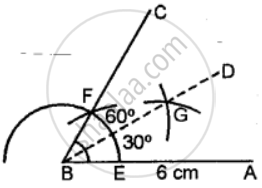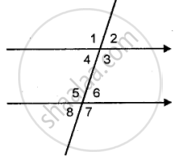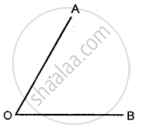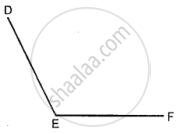Advertisements
Advertisements
प्रश्न
Draw line AB = 6 cm. Construct angle ABC = 60°. Then draw the bisector of angle ABC.
उत्तर
Steps of Construction:
1. Draw a line segment AB = 6 cm.

2. With the help of compass construct ∠CBA = 60°.
3. Bisect ∠CBA, with the help of a compass, take any radius which meet line AB and BC at point E and F.
4. Now, with the help of compass take radius more than `1/2` of EF and draw two arcs from point E and F, which intersect both arcs at G, proceed BG toward D ∠DBA is bisector of ∠CBA.
APPEARS IN
संबंधित प्रश्न
If ∠1 = 120°, find the measures of : ∠2, ∠3, ∠4, ∠5, ∠6, ∠7 and ∠8. Give reasons.

In your note-book copy the following angle using ruler and a pair compass only.

In your note-book copy the following angle using ruler and a pair compass only.

Construct the 45° angle, using ruler and a pair of compass only.
Construct the 135° angle, using ruler and a pair of compass only.
Draw a line segment AB = 6.5 cm. Locate a point P that is 5 cm from A and 4.6 cm from B. Through the point P, draw a perpendicular on to the line segment AB.
In the following figure, BA is parallel to CD. Find the angles a, b and c:

Draw a line AB = 9 cm. Mark a point P in AB such that AP=5 cm. Through P draw (using set-square) perpendicular PQ = 3 cm. Measure BQ.
Draw a line segment AB = 6 cm. Without using set squares, draw angle OAB = 60° and angle OBA = 90°. Measure angle AOB and write this measurement.
Without using set squares, construct angle ABC = 60° in which AB = BC = 5 cm. Join A and C and measure the length of AC.
